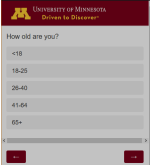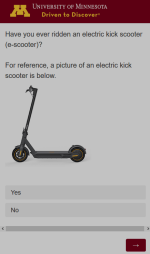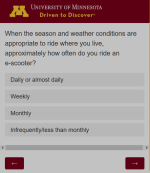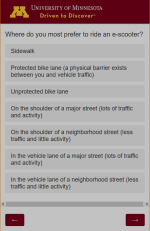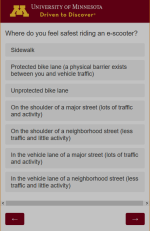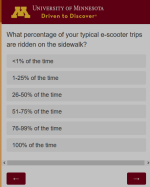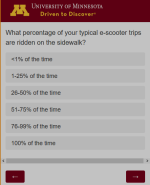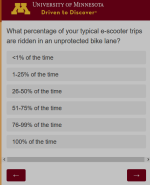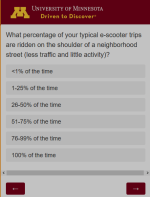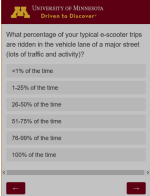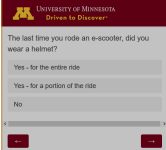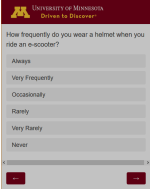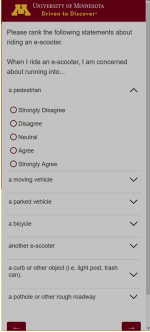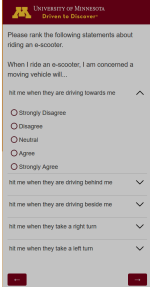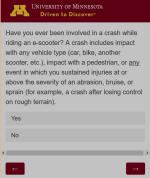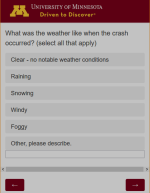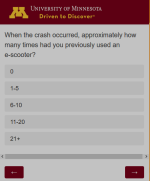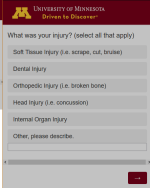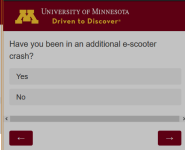maddie1654 said:
I can remove your response from the data - there were only 2 responses before the "kick scooter" clarification, so this will be easy to do.
My guess is that's probably a good idea, though not knowing what the quantity of responses you have is (or is going to be), you might have enough "real" data to totally swamp the off-chart responses.

If you haven't already, you might want to go to the various e-skate / esk8 forums, *especially* the facebook, twitter, and other social-media groups, to post this survey. I would bet that there are orders of magnitude more riders there than on ES. Even though esk8s are not exactly the same as e-kickscooters are, the problems involved are very very similar (with the major exception of the giant lever on the front of the kickscooters), and the rider experiences would likely be very useful to this project. As well as that many of the esk8ers are also likely to have expereince on kickscooters, e- or not.
To give you some more background on the research, my lab is working with 2 other labs at UMN that focus on sensing/estimation/control and AI processing. These labs are creating technology that will be integrated into the scooter, with the ultimate goal of improving rider safety. My lab specifically is a human factors lab that focuses on gathering user needs and the human interaction with the technology. Unfortunately, there is not a lot of information available about the mechanisms of e-scooter injury, so we created the survey to get more information about current rider safety needs. The results of this survey will help guide the other 2 labs in creating technology that truly fits user needs.
If you would like some detailed observation information about the way I see riders operate around here, during my commutes and other trips around the area, I can post that here (since it doesn't fit within the survey questions). Then you can also ask questions about the observations which might get more specific information on the bits that concern you most.
It would be interesting to see how you use AI (etc) to help control these to help with crash prevention, while also *not* interfering with the rider's own ability to control it (as their own judgement might be much better than that of the AI, or their sense data might be of higher quality than that the system is getting, for whatever reason).
Another data-gathering method would be to have very experienced riders be instrumented along with their rides, and then have them ride in uncontrolled and controlled conditions that are monitored externally as well (video, maybe even lidar, motion capture, etc) in realworld situations that have a potential for causing a crash, to gather data on what *they* do to avoid such things, to see if any of it can be implemented within the control AI. Some if it simply can't be, because it will involve things only the rider could do due to their much greater mass and much higher COG, moveability (I know that's the wrong word, but I'm too tired to remember the right one), etc.
You could also instrument completely inexperienced riders (with "michelin man" protection suits on :lol: ) and do the same thing, to see how the average person reacts to the same situations, to find out the kind of things that the AI is going to have to be able to deal with on a very common basis (especially with the "scooter rentals" where you have a lot of first-time-riders just wanting a quick way to get down the block or whatever, but that have absolutely no idea of the rider-vehicle interactions and physics involved, or the things they need to watch out for, especially since almost all of these things have tiny 8" or less wheels that don't go over even very teensy bumps very well, if at all.
To answer some of your questions - you are correct, the survey does not focus on the design specifically, more on gathering information to better inform the design. Perhaps I could have used a different title! Also, many of the questions are intentionally about safety perception. Many riders have not been in a crash, so this was the best way to gather information about their safety needs (at least from the perspective of the rider). If a survey respondent has been in a crash, the answers to the related questions will provide more information about actual safety rather than perceived safety.
Makes sense.
FWIW, you're going to get riders filling the survey out that *have* been in a crash, but won't tell you about it because they don't know how important that information is to your survey, and it's either embarrasing to them or "incriminating" (even if anonymous) in that it was their fault for riding the way they do. (we see this sort of evasion all the time with noobs that come here with stuff that doesn't work, and their initial post often implies it never worked when in fact it worked fine until they messed with it, or crashed it, or whatever...but we have to drag that out of them kicking and screaming so that we can then help them with the actual problem instead of the one they think they have). I don't know what you should say in the questions that will make them answer honestly more often, but there is probably something someone really good with psychology or personal interaction experience could do to help with that.
Thank you again for your feedback - it has definitely given me a lot to think about!
Sure--I'm heavily analytic by nature, even when I know little about a subject I can often deduce a fair bit from what's presented, but it's much easier to do with sufficient data, which is much easier to get when the right questions are asked--so I like to help guide people down the right data-acquisition path to be able to ask the right questions that then answer the questions they *really* needed to ask. If that makes any sense.



